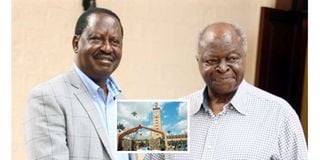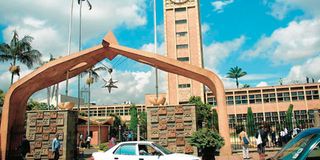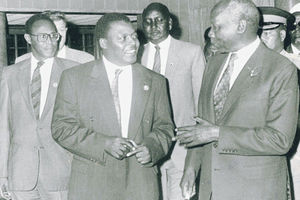Shabaab bomb maker planned to attack Parliament, surveilled Kibaki, Raila

Former President Mwai Kibaki (right) with former Prime Minister Raila Odinga. An al-Shabaab bomber had them surveilled in 2012 as he plotted high-profile attacks. The alleged explosives expert also planned to attack Parliament Buildings (inset).
Titus Nabiswa, alias Mwalim Khalid, a recruit from Majengo, was a foreign fighter who had risen through the ranks to become a senior figure in al-Shabaab.
Described as an explosives expert and operational planner, the Kenyan ‘Amir’ had dispatched tens of al Hijra fighters from Somalia to carry out attacks in Kenya. Reported to have al-Qaida links as well, Khalid returned to Kenya around the middle of 2012 to plot an attack on a bigger target: Parliament.
Key to the plot was a Parliament worker (name withheld for legal reasons) and a long-time serving official of the Pumwani Riyadha Mosque Committee (PRMC), according to classified documents that Kenya submitted to the International Court of Justice (ICJ) last year to support its case in the maritime dispute with Somalia.
Khalid attempted to persuade the parliamentary worker to assist with the plot, said the Monitoring Group, a body tasked by the UN Security Council to investigate the crisis in Somalia.
“In or about June 2012, according to multiple sources, Khalid dispatched a group of Somalia-based al-Hijra fighters to Kenya as part of al-Shabaab’s operations to destabilise the country,” reveals a report by the Monitoring Group on Somalia and Eritrea, pursuant to a United Nations Security Council (UNSC) resolution in 2013.
“Mwalim Khalid’s various plans included a plot to attack the Parliament of Kenya, according to a confidential source that had initial knowledge of it.”
Kibaki, Raila targeted
Upon returning from Somalia, Khalid had been hosted in Mombasa by an accomplice known to the Monitoring Group as Rashid, who would later reveal Khalid had been plotting even higher-profile attacks. Rashid claimed he had been instructed by Khalid to carry out surveillance on then-President Mwai Kibaki and Prime Minister Raila Odinga, according to extracts from the report, which was filed with the UNSC in October 2014.
Although the date was unspecified, the Monitoring Group estimated it to be between June 2012 and no later than October 27, 2012.
Under interrogation by the Kenyan security services, al-Qaida-affiliated Jermaine John Grant in December 2011 also claimed al-Shabaab was planning to attack a number of targets in Kenya, including the Parliament.

Parliament Buildings.
“Information about the parliament plot was also corroborated during a meeting in Tanga on 23 January 2013 in which Rashid alluded to being aware of it,” reads the report, citing an interview on January 24, 2013, with a source with direct responsibility for logistics for al Hijra in the Tanzanian town.
Rashid had fled from Kenya to Tanzania as security agents caught up with his guest, perhaps because of Khalid’s high-prized targets.
On October 28, 2012, while travelling from Nairobi to Mombasa, “most probably to coordinate further attacks in Mombasa”, says the report, Khalid was intercepted at Mariakani.
“Photographic evidence obtained by the Monitoring Group indicates that Mwalim Khalid was in possession of a small arms cache,” the report says.
“Following his interception, Mwalim Khalid led security services to an associate, Omar Faraj, hiding in Mombasa. This led, according to media reports, to a shootout that resulted in both Mwalim Khalid and Omar Faraj being killed by the security services.”
Information received by the Monitoring Group suggests that after the killing of Mwalim Khalid and his failed Parliament plot, al Hijra was forced to rethink its operations, particularly in Mombasa.
The report also accuses the Parliament employee of advising PRMC “on ways and means of concealing its support to al-Shabaab through al Hijra” following the enactment of the Kenya Prevention of Terrorism Act in October 2012. This information was gleaned from interviews with former al Hijra members and officials of the PRMC between September and December 2012.
“Despite its public and firm denial of funding or assisting recruitment for al-Shabaab, the Pumwani Riyadha Mosque Committee continues to view its support of al-Shabaab through al Hijra as a religious obligation,” the report claims.
Evidence
The Monitoring Group, in the report, said it obtained sufficient information substantiating the threat that Khalid “represented in terms of his intent and capability as a Kenyan al-Shabaab ‘Amir’”.
“This has included information from officials knowledgeable about al-Shabaab’s threat capability in Kenya and the region, and testimonies from al Hijra members, including audio recordings of a current al Hijra fighter’s assessment of Mwalim Khalid.”
The Monitoring Group also noted that while some al Hijra fighters had fled Somalia because of disaffection with al-Shabaab, “Mwalim Khalid’s return was more than likely based on operational necessity and his convictions in extending al-Shabaab’s ‘Jihad’ to Kenya”.
Somalia-based al Hijra fighter Athman Ahmed, alias Mwarabu, expressed the group’s pragmatism succinctly during a discussion at a safe house in Mwanza, Tanzania, on January 19, 2013.
“[We] had planned everything. We were ready even before that. When Titus [Mwalim Khalid] was [killed], it ruined our plans. But we didn’t lose our morale. We started planning afresh,” the Monitoring Group wrote, citing confidential audio recordings of Mwarabu, Ruta and others in Mwanza.
Ruta was an alias for Ibrahim Ramadan Hamisi, another senior al Hijra member.
Almost a month later, in November 2012, Kenyan security services again disrupted a plot involving al Hijra members, including Khubeib Rogo, who had just returned from Somalia, and Swaleh Abdulmajid, who, in 2010, was arrested for attempting to travel to Somalia to join al-Shabaab with UK national Michael Olumide Adebolajo.
“On November 13, 2012, following the disruption of another potential large-scale terrorist attack in Mombasa and elsewhere involving al Hijra members, security services arrested and interrogated Khubeib Aboud Rogo, the son of the late ideological leader of al Hijra. During his interrogation, Khubeib Rogo claimed al-Shabaab had sent at least six suicide bombers to Kenya,” the report says.
“This testimony, albeit obtained under interrogation, is corroborated by another al Hijra fighter returning from Somalia who was arrested on 6 September 2012, and who confirmed that ‘Mohammed Seif’ had been dispatched by al-Shabaab as a suicide bomber.”
Inmates’ accounts
Mohammed Seif was the alias of Elgiva Bwire Oliacha, who was later jailed over grenade attacks in Nairobi. He went missing following his release last year after serving a 10-year jail term. “Information received by the Monitoring Group and corroborated by serving members of al Hijra, including indirect information accessed from al Hijra members in Shimo la Tewa prison in November 2012, strongly suggests that the group had planned simultaneous attacks against multiple targets,” the report states.
According to the report, the Monitoring Group was aware of credible reports circulating within al Hijra circles during November 2012 that suggested Khubeib Rogo had returned from Somalia to avenge his father’s death. The senior Rogo, a radical Islamist cleric, was killed in a drive-by shooting in Mombasa on August 27, 2012.
A month to his assassination, the UN Security Council had imposed a travel ban and asset freeze on Rogo for supporting terror activities.
The Monitoring Group also understands that Khubeib Rogo had alluded to seeking revenge on behalf of his father during his interrogation by the security services.
The Monitoring Group believes these targets may have included a church, a police station in Mombasa and other public facilities.





